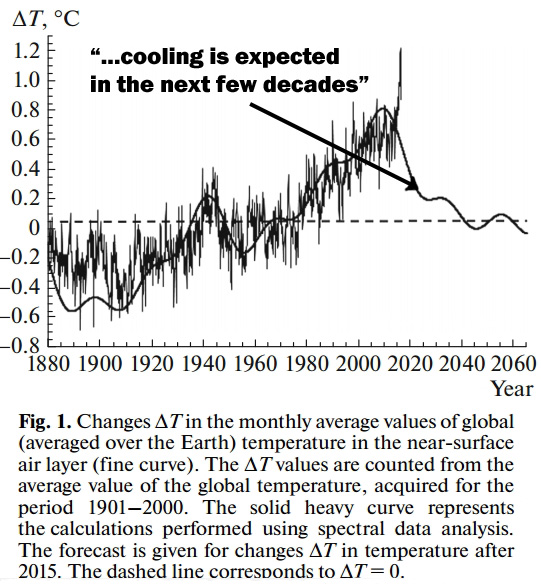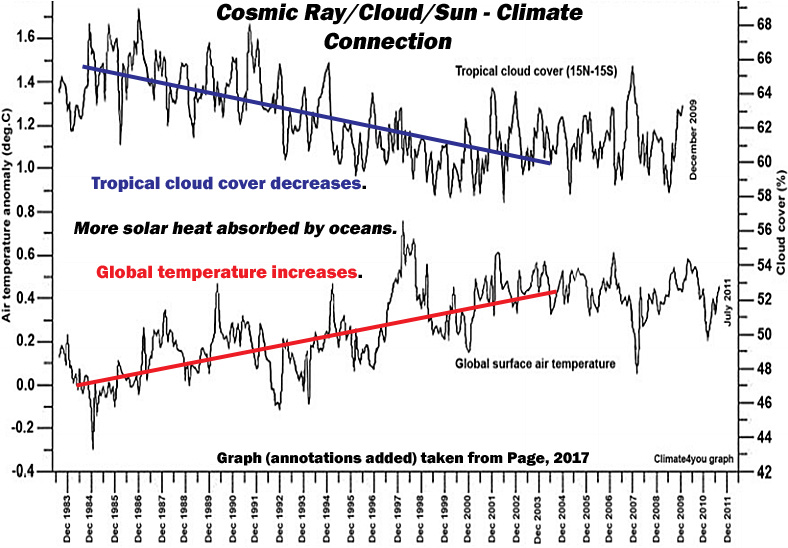A new scientific paper authored by seven scientists affiliated with the Russian Academy of Sciences was just published in the scientific journal Bulletin of the Russian Academy of Sciences: Physics.
The scientists dismiss both “greenhouse gases” and variations in the Sun’s irradiance as significant climate drivers, and instead embrace cloud cover variations — modulated by cosmic ray flux — as a dominant contributor to climate change.
A concise summary: As cosmic ray flux increases, more clouds are formed on a global scale. More global-scale cloud cover means more solar radiation is correspondingly blocked from reaching the Earth’s surface (oceans). With an increase in global cloud cover projected for the coming decades (using trend analysis), a global cooling is predicted.

“This paper argues that the methods used by the establishment climate science community are not fit for purpose and that a new forecasting paradigm should be adopted. Earth’s climate is the result of resonances and beats between various quasi-cyclic processes of varying wavelengths. It is not possible to forecast the future, unless we have a good understanding of where the earth is in time in relation to the current phases of those different interacting natural quasi periodicities. Evidence is presented specifying the timing and amplitude of the natural 60 ± year and, more importantly, 1000 year periodicities (observed emergent behaviors) that are so obvious in the temperature record. Data related to the solar climate driver are discussed and the solar cycle 22 low in the neutron count (high solar activity) in 1991 is identified as a solar activity millennial peak and correlated with the millennial peak – inversion point – in the RSS temperature trend in about 2004. The cyclic trends are projected forward and predict a probable general temperature decline in the coming decades and centuries. Estimates of the timing and amplitude of the coming cooling are made. If the real climate outcomes follow a trend which approaches the near term forecasts of this working hypothesis, the divergence between the IPCC forecasts and those projected by this paper will be so large by 2021 as to make the current, supposedly actionable, level of confidence in the IPCC forecasts untenable.”

https://www.climatedepot.com/2017/03/23 ... f-cooling/
Un resumen conciso: a medida que aumenta el flujo de rayos cósmicos, se forman más nubes a escala global. Una mayor cobertura de nubes a escala global significa que más radiación solar queda bloqueada para que no llegue a la superficie de la Tierra (océanos). Con un aumento de la nubosidad global previsto para las próximas décadas (usando análisis de tendencias), se predice un enfriamiento global.
Se producen más plantas pero de menor nivel nutritivo.CacaDeLuxe escribió: ↑03 Dic 2019 13:02 La Tierra es más verde ahora gracias al aumento del CO2
Un estudio concluye que desde 1982 se ha producido un ascenso significativo de biomasa verde en el 40% de las regiones del mundo.
https://www.publico.es/ciencias/tierra- ... as-al.html
Aprendamos de los Romanos y los medievales.

Ellos no dejaban la cuadriga con el motor en marcha, ni tan siquiera los nobles dejaban así sus palanquines.
Recuerdo con envídia ver la villa de reposo de Trajano, con sus paneles solares y sus jardines hidropónicos. Esa gente sí supo frenar el calentamiento global que sus malas praxis causaron en su época.

-Maldita Gretam Tvmberia y su idea de apagar los motores de los barcos y volver al remo...
Y ya si hablamos de los dinosaurios, ¡El horror!

Bien extinguidos están.
Bromas a parte, da igual lo que hagamos. Estamos muertos y enterrados desde hace años.
https://es.wikipedia.org/wiki/Paradoja_de_JevonsEl efecto rebote, o más comúnmente la paradoja de Jevons, denominada así por su descubridor William Stanley Jevons (1835-1882) , economista y filósofo inglés, afirma que a medida que el perfeccionamiento tecnológico aumenta la eficiencia con la que se usa un recurso, es más probable un aumento del consumo de dicho recurso que una disminución. Concretamente, la paradoja de Jevons implica que la introducción de tecnologías con mayor eficiencia energética pueden, a la postre, aumentar el consumo total de energía.












 la explotacion de recursos naturales no tiene que ser malo. el sol o el viento son recursos naturales. jeje dicho esto, la tendencia es que todo lo contrario, y tenemos el ejemplo con la energia que cada vez mas se apuesta por energias limpias y buscando alternativas.
la explotacion de recursos naturales no tiene que ser malo. el sol o el viento son recursos naturales. jeje dicho esto, la tendencia es que todo lo contrario, y tenemos el ejemplo con la energia que cada vez mas se apuesta por energias limpias y buscando alternativas.



